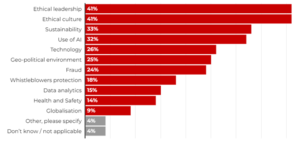Improved accuracy in stock reporting could boost retailer’s sales up to 8%

Retail stores are missing out on millions of pounds in increased sales due to inventory record inaccuracy, according to new research from emlyon business school. In fact, the researchers found that retailers could boost their sales by up to 8% annually if their stock record was more accurate.
The research was conducted by Yacine Rekik, a professor of operations and supply chain management at emlyon business school, alongside research colleagues from Cardiff Business School and TU Darmstadt, and in collaboration with the industry and trade body for shrinkage and consumer demand, Efficient Consumer Response (ECR). Though it is a common knowledge that inventory record inaccuracy has a negative impact on sales in the retail sector, this is the first study which has put an actual specific figure on the financial implications of inaccuracy in inventory reporting.
To understand this real financial impact, the researchers worked with seven well-known retailers – across four European countries – in the grocery/general merchandise and fashion/apparel sectors. They studied data on around 233,000 different individual products throughout the whole research project.
To collect these findings the researchers conducted a 24-week inventory experiment where they compared two different stores per retailer, with each store having a different stock take method. In one of the stores the researchers completed a thorough stock take at the beginning and end of the 24-week period but not during this, whilst for the other store the researchers completed a thorough stock take at the beginning and the end, but also in the middle of the 24-week period, re-correcting any errors in inventory stock numbers.
Researchers then compared the differences in profit margins per store, finding that the store which had a more accurate and frequent stock take had on average 4-8% better profit margins. The researchers also found that at any point in time, around 60% of the retailer’s inventory records are likely to be wrong. This not only impacts the firm’s sales and turnover, but also the stock that is available to customers, often leaving shelves unfilled. Correcting these inaccuracies can lead to an increase in the average sales of the retailer between 3.83% and 8.38% with an average of 5.98% across all retailers, according to the researchers.
Professor Yacine Rekik says,
“There can be a number of reasons as to why these stock records can be so inaccurate. Most of the time it comes down to damages to products, misplacement problems such as products being moved to different shelves, human or computer errors when entering stock levels into systems, or even the products being stolen. It is extremely important that retailers look to report their stock levels more accurately and more regularly so that they are not under or over reporting stock levels – as this inaccuracy either way has a negative effect on annual turnover.”
When looking into these inventory inaccuracies, the researchers also found that the type of product also had an impact on how accurately it was reported for inventory purposes. The researchers found that products which can be described as fast-moving goods, generating up to 75% of the whole turnover, are much more likely to be inaccurately reported in stock takes compared to slow-moving goods.
Professor Yacine Rekik also says,
“There are a number of ways that retailers should be looking to improve their stock accuracy, which would consequently boost sales and annual turnover. Firstly, looking into technological solutions, such as intelligent products identification which are able to update inventory levels when purchased is a way to remove human error and shrinkage risk, but of course costly and fairly untested. Whilst more simply, improving the efficiency, frequency and intelligence of current stock taking practices is a practical way to do so. Though this would take more time and be more costly in the short-term, it would ensure inventory is more accurately reported, eventually saving money long-term. Whilst another option would be to employ business intelligence, such as data analytics to stock-taking in order to better identify stock evolution patterns and improve the record accuracy.”
The researchers are now looking into the second phase of this research project. After confirming and identifying the specific financial implications of inaccurate stock inventory in the first phase, they will now be researching innovative and effective ways that retailers can use for more accurate inventory reports thereby improving their financial performance. Conclusions are soon to be published.






